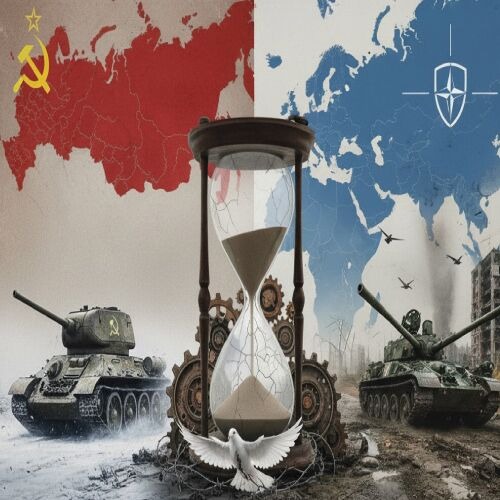After three and a half years of ongoing conflict between Russia and Ukraine, both sides are engaged in a long, protracted struggle. As the conflict goes on, the crisis in Ukraine is not simply a 21st-century conflict; it is a manifestation of Soviet political, economic, and military logic, which formerly controlled Eastern Europe. Apart from modern elements of warfare, such as drones and cyberwarfare, the campaign echoes an older strategy, one adopted by the Soviet Union. The latter’s strategy involved controlling neighbours through a defense-offense duality and combining political manoeuvres. The purpose is to create a buffer zone to halt Western advance and secure Russian security.
It is interesting to note that European powers distrust Russia and consider it an aggressor. However, it is worth noting that the expansion of NATO to Russia’s borders is the root cause of the current conflict. In 1997, Russian President Boris Yeltsin approved a text on national security that considered the expansion of NATO to the east a threat to Russian security. The induction of Ukraine into NATO would bring the Western military alliance to Russia’s doorstep, disregarding Russia’s long-standing desire to have a buffer zone. Besides, Russia has historical ties with Ukraine; losing the latter to the West is a double blow: strategic and symbolic.
Scholars have argued that the current Russian strategy can be traced back to the post-revolutionary period following the Bolshevik Revolution in 1917. The Frunze-Trotsky debate in the early 1920s laid the groundwork for Soviet political and military doctrine. It explains the soviet doctrine of ‘Superiority in the Correlation of Forces’, which focuses on increasing the quality and quantity of forces to maintain control. In the subsequent years, the Soviet political posture remained defensive, while the military adopted an offensive posture. The total mobilisation of society, industrial might, and the primacy of offense (the concept of operation in depth) in the defense and spread of socialism exhibit this dynamic defense-offense duality. In this duality, the role of strategic patience is vital because it shows Russian confidence in its ability to endure hardships patiently and then utilise the opportunity to achieve its objective. In Putin’s Russia, the Marxist-Leninist ideology of the USSR has been replaced by nationalist rhetoric and the defense of Russian civilisation, but the defense-offense duality persists.
An analysis of the conflict in Ukraine that started in 2022 reveals that the initial optimism of the Russians was to take Kyiv in 3 days and subdue Ukraine in 6 weeks. To accomplish this ambitious plan, the Russian military relied on old Soviet deep operations tactics with lightning speed. However, the resistance of Ukrainian forces and civilians subverted the Russian plan for an immediate victory. With the withdrawal from Kyiv, the nature of the conflict shifted to attrition and positional tactics. The long, brutal nature of this defensive warfare is another reminiscence of the Soviet mindset of diluting the will of the enemy, as happened against Nazi Germany in 1942. As the western support to Ukraine comes in, it has launched multiple counteroffensives, the deadliest of which was the drone attack that damaged Russian bomber fleets in operation Spiderweb.
The conflict shows a clear reminder that, despite the use of 21st-century weapons, Moscow continues to fight with a Soviet mentality. Targeting the enemy’s infrastructure far behind the front lines is a contemporary version of deep battle. It resembles the Soviet mindset of using social forces, the population, and civilian infrastructure to create bargaining leverage. Similarly, drone and artillery attacks in Sumy, Donetsk, and Kherson demonstrate Russia’s transition to an attritional strategy, which aims to advance gradually rather than quickly. The attacks on civilian and energy infrastructure by Russian forces underscore the soviet ideology of breaking the civilian will to break the state. This is akin to the Soviet philosophy of endurance through devastation, which relies on outlasting the opponent rather than outmanoeuvring them.
The diplomatic efforts to bring a ceasefire continue, but an intrinsic stalemate persists: Ukraine’s bid to join NATO and the Russian notion of securing security through a buffer zone. For Russia, diplomacy demands recognition, not reconciliation. It exhibits the Soviet custom of viewing negotiations as instruments to maintain, not relinquish, superiority in correlation of forces. It sounds like the Brezhnev Doctrine, which posits that security emanates from dominance within its sphere of influence. Under Putin, the policy of Near Abroad shares the same principle as a buffer zone, in this case, Ukraine, to ward off Western outreach.
Since the start of the conflict in Ukraine, there has been speculation about the Russian economy. The government injected massive funding into the economy to support its defensive efforts. The industries that used to make civilian goods have been diverted to produce ammunition and drones. Since labour productivity and the employment rate determine economic growth, currently, in Russia, these two indicators are under severe pressure. In short, the civilian needs have been subordinated to military goals. This has been the pattern of the Russian war economy involving centralisation and government interference to support war efforts. To sum up, the Russian-Ukrainian conflict has entered its third year, with no sign of a ceasefire, and the war of attrition continues. Against this backdrop, Moscow’s military, political, and economic strategy resembles that of the USSR. The urge to maintain superiority in the correlation of forces in war and diplomacy is visible. The only formidable opposition is the West’s support for Ukraine. However, the latter lacks sufficient manpower if the conflict drags on further. In this situation, Putin, like the USSR, is relying on strategic patience to break the Ukrainian resistance.
This article was published in another form at https://strategicforecast.cissajk.org.pk/?p=22920
Muhammad Kumail Mehdi is a Research Assistant at the Center for International Strategic Studies in Islamabad.

